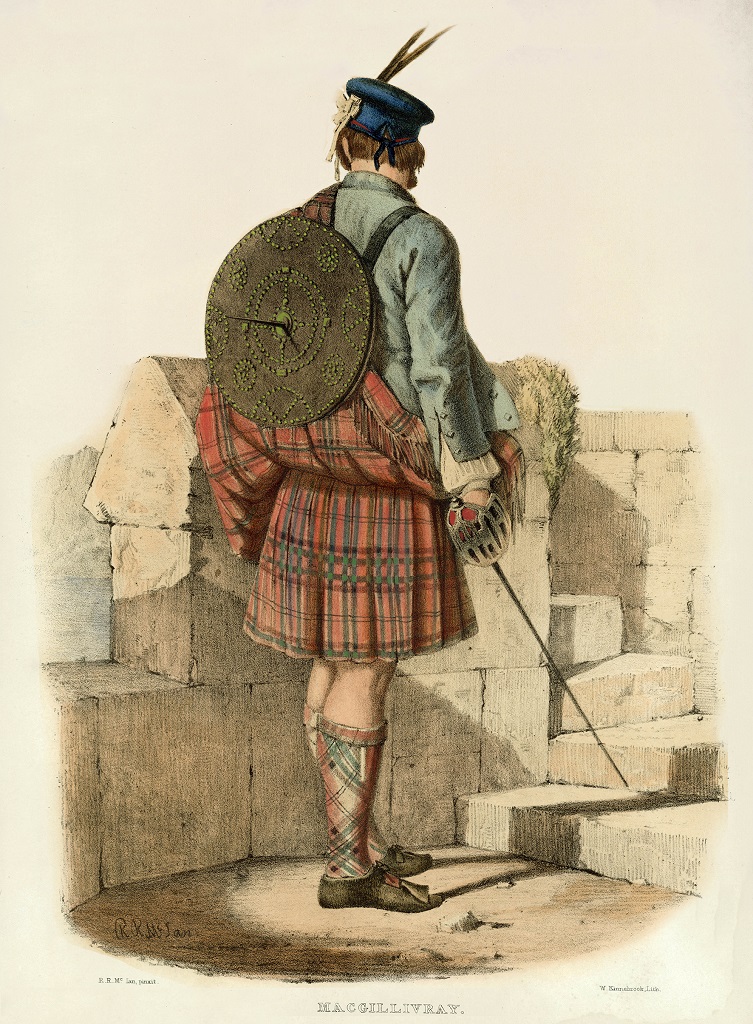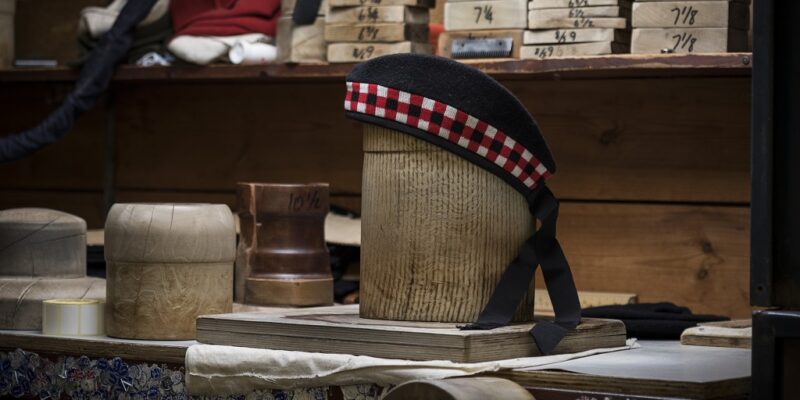Bonnet making has long been a tradition in Scotland and there’s one place renowned for it more than anywhere else…
MORE FROM SCOTLAND MAGAZINE
Stewarton in east Ayrshire has been known in Scotland as The Bonnet Toun (town) for centuries. Records show that the bonnet trade existed by 1650, but it is likely that woollen bonnets were being knitted in and around the town well before that.
The history of bonnet making in Stewarton is believed to date back to the end of the 16th century and the records of the original guild of bonnet makers date from the 17th century onwards. However, while Stewarton is undoubtedly the most famous place in Scotland for bonnet making, it was not the only place making them. The nearby town of Kilmarnock was known for the ‘Big Kilmarnock Bunnet’. The craft was also quite widespread among farmers in the Lowlands, who knitted in the winter when they could not work outside.
Bonnets were first mentioned in the late 14th century and most likely were fairly crude items of headgear then. The first professional bonnet makers were recorded in the 15th century. They created the flat caps, known locally as bonnets, which were very fashionable among men at the time. It was a simple craft, requiring inexpensive materials and little special equipment.

While English bonnets were made from cloth or velvet, the Scots bonnet was knitted using wool from local sheep. Rather than using fleece wool, they used skin-wool as this was thought to waulk (felt or thicken) more readily. This wool was obtained from slaughtered sheep. The wool would have been coloured using blue woad, a natural dye from plant leaves famously used by the Picts as body paint. Indian indigo would be used later, once the trade routes were established.
The dyed wool was then heated with pungent mordant urine before being washed and spun in the river. Originally, bonnets were made from course blue wool – plain, rough, heavy and in one basic form. Set on a narrow headband, the crown might be a little wider than the head, or broad enough to shade the face of the wearer. Commonly worn in Scotland, they would have provided some protection against the inclement Scottish weather and would have been in a Tam o’ Shanter style, but without the toorie (the tassel or bobble).
Bonnets were knitted in the round on three needles or pins about 3/8 inch in diameter and 16 inches long. The weight of the work was supported by sticking one needle into a leather picque or knitting belt, which was strapped around the knitter’s waist. Then the two free needles, in combination with the fixed one in the belt, were used to create the stitches. Extra needles were pushed into the belt and pulled out when required, as the bonnet increased in size.
When completed, the bonnets were washed and milled to felt the yarn, a process known as waulking. Sometimes this was done by hand, although most bonnet makers had access to a water-powered waulk mill. They were then stretched to the regulation size on a circular board or stretcher. This technique ensured they would not lose their shape in the rain. Once dry, the pile was raised with a steel brush. These bonnets were about 12 inches in diameter
and vented at the back to give a more secure fit.

The Kilmarnock bonnet was much larger, measuring approximately 15 inches. The weight and quality of the Stewarton bonnets was important and to ensure that they were up to the high standards demanded in Glasgow, the Bonnet Court of Corsehill appointed inspectors, known as sichers. Their job was to inspect and approve the caps. There were both town and county sichers, and both issued fines. The caps were to weigh one pound, 15 ounces per dozen; if they were found to be underweight, they were destroyed. When some traders complained of having received ‘wet caps’ (bonnets soaked in water to make them heavier) the makers were duly fined.
By 1729 the Bonnet Court consisted of 35 members. Occasionally, to maintain the price of the bonnets, the Court would order all work to be stopped in the town, a practice known as an idlesett. These idlesetts could sometimes last for weeks. An order issued on 17 January 1754, stated: “No bonnets to be made, only caps (night caps) for the space of six weeks, under the penalty of 5 shillings for each day’s transgression.” In 1729, this entry appears in the Minutes of The Bonnet Court: “None to go through the town of Glasgow with bonnets after the 22nd Inst excepting those wrought before that day, under the penalty of £50 Scots.”
It was not until the 18th century that new shapes in bonnets appeared. A flourishing trade also developed for military headgear. Stewarton was most famous for its regimental beret-style hats, including the Glengarry, the Balmoral and the Tam o’ Shanter, which all met the rigorous Ministry of Defence requirements. Toories became fashionable, then dicing, plumes and rosettes were added to enhance the style. Headbands and dicing strengthened the garment, with padding and stiffening, to enhance the shape.
Toward the end of the 18th century, the Industrial Revolution brought transformation of manufacturing
in Stewarton as well as across the country. Machinery invented by James Hargreaves, Richard Arkwright and Samuel Crompton made the process for spinning cotton and wool faster and cheaper than old spinning wheels. New factories were erected in the area. This effectively put an end to the cottage industry, much to the discontent of the small farmers and cottagers who lost their much-needed earnings from the winter work. Mostly the craftsmen were humble folk, earning a modest living, but against the odds, a few enterprising craftsmen made their fortunes.
The first bonnet factory was established in Stewarton in 1820 by Robert Sim. This factory was built on the banks of the Annick Water at Robertland Mills and remained in existence until 1987 when Mrs Jenny Sim retired.
Thomas Mackie (1791-1869) founded a spinning and dyeing business in Stewarton. It is said he arrived from the nearby town of Irvine, pushing a barrow load of dyestuff and feathers, with the intention of supplying the dyeing requirements of local bonnet makers.
In the 1840s Robert Mackie decided to leave the family spinning and dyeing business to set up his own bonnet making business, which he did in Holm Street in 1845. By the 1860s, there were 10 bonnet makers in Stewarton, three woollen spinners and eight manufacturing agents. The industry continued to grow and other forms of headgear began to replace the traditional Scottish cap or bonnet. This meant that they had to widen their range, expanding into stockings and heavy underwear. The first rib vest was also produced in Stewarton.
Now, in common with many cities in Europe, Glasgow has 14 ancient Craft Guilds, the youngest of which is The Incorporation of Bonnetmakers & Dyers (1597). Robert Linton, Deacon of the Incorporation, says: “Each Guild supervised quality of production within the city and members had exclusive trading rights within the city boundaries. The Glasgow Guild gave trading rights to the Bonnetmakers of Stewarton, marked each year by the Glasgow Deacon’s involvement with the Stewarton Bonnet Fair.”
“All exclusive rights in Scottish burghs were swept away by the Rescissory act of 1846,” continues Linton. “The Guild’s purpose is now charitable – principally supporting students undertaking relevant courses at local colleges. While the bonnet is no longer in common use as an item of male headgear and Stewarton is now the sole production centre in Scotland, the guild now has several members active in millinery.”
Stewarton supplies its products to retailers and military regiments, which are worn by clans and pipers across the world. For a list of stockists of its bonnets, go to robertmackie.com/stockists.
MORE FROM SCOTLAND MAGAZINE

SCOTLAND MAGAZINE
Published six times a year, every issue of Scotland showcases its stunning landscapes and natural beauty, and delves deep into Scottish history. From mysterious clans and famous Scots (both past and present), to the hidden histories of the country’s greatest castles and houses, Scotland‘s pages brim with the soul and secrets of the country.
Scotland magazine captures the spirit of this wild and wonderful nation, explores its history and heritage and recommends great places to visit, so you feel at home here, wherever you are in the world.